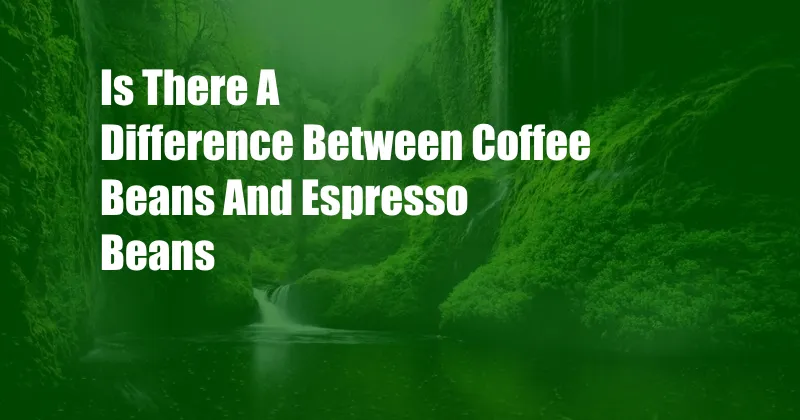
The Distinction Between Coffee Beans and Espresso Beans: A Comprehensive Guide
Whether you are a seasoned coffee connoisseur or a casual java enthusiast, you may have pondered the alleged disparity between coffee beans and espresso beans. Intrigued by this enigma, I embarked on a quest for enlightenment, and my discoveries will be unveiled in this comprehensive blog post.
Defining the Difference: A Tale of Roast and Grind
At their core, coffee beans and espresso beans are essentially the same. They originate from the same coffee plant, Coffea Arabica or Coffea Canephora. The distinction arises during the roasting and grinding processes.
Roasting: Coffee beans undergo various roasting levels, ranging from light to dark. Espresso beans are typically roasted to a darker shade, resulting in a more intense flavor and higher caffeine content. The darker roast imparts a caramelized or chocolatey aroma to the espresso.
Grind: Espresso beans are ground much finer than regular coffee beans. This fine grind creates a dense, pressurized puck when tamped in the portafilter, enabling the extraction of espresso’s concentrated flavor and crema.
History and Meaning of Espresso
Espresso’s origins can be traced back to the late 19th century in Italy. Angelo Moriondo, a Turin inventor, developed the first espresso machine in 1884. This revolutionary appliance employed steam pressure to force hot water through finely ground coffee, producing a rich and potent brew.
Espresso holds special significance within Italian culture. It is often served as a morning pick-me-up or an afternoon stimulant. Its robust flavor and immediate caffeine jolt have made espresso a beloved beverage in cafes and households across the globe.
Debunking the Myth of “Espresso Bean Varieties”
Contrary to common belief, there is no such thing as a distinct “espresso bean variety.” The misconception stems from the fact that the term “espresso bean” refers to the roasting and grinding characteristics, not the type of coffee bean.
Coffee beans from various regions and cultivars can be used to create espresso. However, certain arabica varieties, such as Arabica Typica and Arabica Bourbon, are known for their suitability for espresso due to their inherent flavor profiles.
Roasting and Blending for the Perfect Espresso
The art of creating exceptional espresso lies in the careful selection of coffee beans and the harmonious blending of roasts. Blending different coffees allows roasters to balance acidity, sweetness, bitterness, and body to achieve the desired flavor profile.
For a complex and nuanced espresso, roasters may combine coffee beans from multiple origins and roast levels. A typical espresso blend often consists of dark-roasted beans for intensity and crema, along with lighter-roasted beans to add sweetness and balance.
Tips and Expert Advice for Enhanced Espresso
Select the Right Beans: Opt for high-quality, freshly roasted coffee beans from reputable sources.
Fine-tune the Grind: Experiment with different grind sizes to find the optimal setting for your espresso machine.
Dial In the Machine: Calibrate your espresso machine to ensure proper water pressure and extraction time.
Tamp Properly: Evenly and firmly tamp the ground coffee in the portafilter to create a dense puck for optimal extraction.
Clean Your Equipment: Regularly clean your espresso machine to prevent buildup and maintain optimal performance.
Troubleshooting Common Espresso Issues
Bitter Espresso: Overextraction occurs when the espresso is brewed for too long. Adjust the grind size to a coarser setting or shorten the extraction time.
Sour Espresso: Underextraction occurs when the espresso is brewed for too short a time. Adjust the grind size to a finer setting or extend the extraction time.
No Crema: The crema is the golden-brown foam that forms on top of espresso. Its absence indicates insufficient extraction or old coffee beans. Ensure proper tamping and use freshly roasted beans.
Frequently Asked Questions:
Q: Is espresso stronger than regular coffee?
A: Espresso contains a higher concentration of caffeine than regular coffee due to its finer grind and higher brewing pressure.
Q: What is the difference between a single and double espresso?
A: A single espresso is approximately 1 ounce, while a double espresso is around 2 ounces. A double espresso contains more caffeine and flavor compounds.
Q: Can I make espresso with a regular coffee maker?
A: No, an espresso maker is specifically designed to use pressurized water to extract the concentrated flavors from finely ground coffee.
Conclusion
In essence, the difference between coffee beans and espresso beans lies in the roasting, grinding, and brewing techniques. Espresso beans undergo a darker roast and finer grind to produce a rich, concentrated, and highly caffeinated brew. Whether you prefer the bold intensity of espresso or the smooth flavor of regular coffee, understanding the nuances between these two brewing methods will enhance your coffee experience.
So, the next time you order an espresso, take a moment to appreciate its unique origins and the skilled craftsmanship that transforms ordinary coffee beans into a truly exceptional beverage.